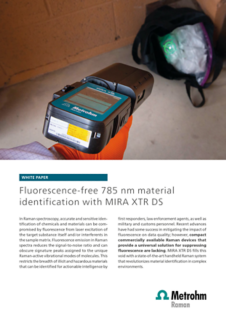The evolution of handheld 785 nm Raman spectroscopy: Raman extraction from fluorescence interference
Nov 1, 2021
Article
MIRA DS (Metrohm Instant Raman Analyzer) is a handheld Raman system that identifies materials using 785 nm laser excitation. The advantages of using 785 nm Raman are well understood. Excitation with shorter wavelengths produces strong Raman scattering with short acquisition times. This results in a high signal-to-noise ratio and provides excellent spectral resolution with lower power draw. These are just some of the reasons that handheld Raman has become so popular over the last two decades.

The sensitivity of Raman at 785 nm also means that lower laser powers can be used. Lower laser powers help to protect sensitive samples from burning or ignition. The silicon detectors used at shorter wavelengths do not need to be cooled, further extending battery lifetimes. The net result is that 785 nm systems can be very small and still provide fast and accurate material identification for long hours in the field.
Learn more about how MIRA became mobile in our previous blog post.
However, while this is considered the «sweet spot» for both a strong signal and fluorescence mitigation among possible wavelengths, approximately 10% of Raman active materials fluoresce under interrogation with 785 nm Raman systems [1]. For example, Gum Arabic is a widely used filler and binding agent. When sampled with 785 nm systems, its fluorescence overwhelms the Raman signal (more on this subject later). Similarly, cutting agents (e.g., sucrose found in street drugs) fluoresce and can prevent positive identification of the target substance. Dyes can be problematic in the analysis of tablets, foodstuffs, art, and plastics as well. Often, weak Raman features can still be observed in fluorescent materials with 785 nm interrogation, but fluorescence mitigation is crucial for library matching.
Previous recommendations to overcome fluorescence
When fluorescence is an issue, 1064 nm laser excitation is often recommended. The tradeoffs include higher laser power, increased sample heating, longer interrogation times, and low Raman scattering efficiency. Often, this means larger instruments with shorter battery lifetimes. Instruments from some manufacturers require longer acquisition times that slow down sampling and can potentially damage the sample.
 Share via email
Share via email





?ts=1675862666832&$orig-5000$&dpr=off&bfc=on)

?qlt=85&wid=1600&ts=1675862666863&dpr=off)





